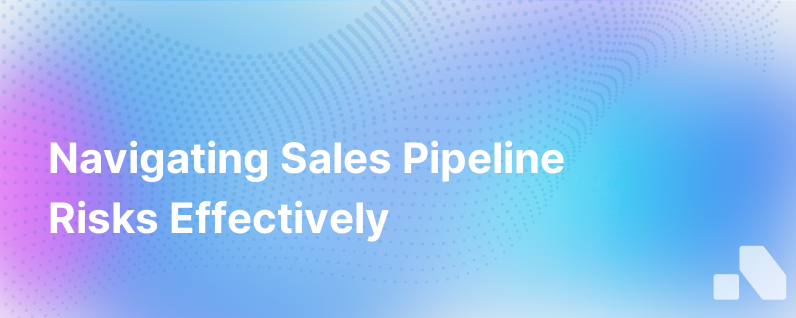Sales Pipeline Risk
Published on August 18, 2023 by David Zhang
Every sales organization understands that a pipeline is more than a mere sequence of potential sales; it is the lifeline that fuels the company's growth. However, lurking within the confines of this pipeline are risks that can jeopardize revenue, forecasting accuracy, and overall sales performance. It is crucial to recognize and manage these risks effectively to maintain a consistent and reliable sales operation. In this article, we're going to dissect the anatomy of sales pipeline risk, exploring its various forms and delivering strategies to mitigate its negative impacts.
Understanding Sales Pipeline Risk
Before we delve into the intricacies of managing risks, it's important to understand what sales pipeline risk actually is. In essence, sales pipeline risk refers to the likelihood that your sales pipeline will fail to meet your company's objectives—be it revenue targets, customer acquisition goals, or growth projections. These risks emerge from various sources, such as individual deal risks, systemic sales process inefficiencies, or larger market and economic factors.
Sources of Sales Pipeline Risk
Sales pipeline risks can be broadly categorized into three groups: deal-level risks, pipeline-level risks, and environmental risks.
-
Deal-Level Risks: These are risks associated with specific opportunities within the pipeline. They include the probability of a deal stalling, the accuracy of the estimated deal size, and the win probability. Forecasting inaccuracies, poor qualification, changes in stakeholders, and a lack of understanding of the buyer's journey can dramatically impact these risks.
-
Pipeline-Level Risks: These risks arise from the overall health and dynamics of your sales pipeline. A lack of sufficient deal flow, an imbalance between different pipeline stages, and an overreliance on certain accounts or deals are some factors that pose serious risks.
-
Environmental Risks: Changes in market conditions, competitive dynamics, regulatory changes, and shifts in buyer behavior fall into this category. These are risks external to the organization but can have profound effects on the pipeline's performance.
Identifying and Measuring Risk
Risk identification in your sales pipeline begins with data analysis. It's essential to gather accurate data on every aspect of the sales process, from lead generation to deal closure. Key performance indicators (KPIs) such as lead conversion rate, average deal size, sales velocity, and win rate are vital metrics that can help pinpoint areas of risk.
Advanced CRM tools can enable sales teams to delve deep into analytical data, providing insights and trends that human analysis could overlook. However, in an increasingly complex B2B landscape, even sophisticated CRMs might not be enough. AI-powered platforms, like Aomni, can take analytics a step further, offering predictions and actionable guidance to manage sales pipeline risks effectively.
Strategies to Mitigate Sales Pipeline Risk
Refine Your Qualification Process
Effective deal qualification is one of the most potent weapons against sales pipeline risk. By refining your qualification framework (whether BANT, MEDDIC, or another methodology), you ensure that only viable opportunities with a high chance of closing are pursued, decreasing the probability of inflated, unrealistic pipelines.
Implement Rigorous Forecasting Practices
Accurate forecasting is key to managing and mitigating pipeline risk. Utilizing historical data, sales trends, and predictive analytics can help create more reliable revenue forecasts. Additionally, incorporating a range of scenarios — from conservative to optimistic — can ensure your organization is prepared for different outcomes.
Foster Sales and Marketing Alignment
Ensuring your sales and marketing teams are aligned can significantly reduce pipeline risk. By collaborating closely, marketing can supply sales with high-quality leads that have a higher chance of progressing through the pipeline, while sales can provide feedback to fine-tune marketing efforts further.
Build a Balanced Pipeline
A well-balanced pipeline — diversified across different stages, deal sizes, and industries — is less susceptible to risk. This requires consistent effort from the sales team to not only advance deals but also to replenish the pipeline with new opportunities.
Continuous Pipeline Reviews
Regularly reviewing and cleaning up the pipeline can help to identify stalled deals or inaccuracies in the pipeline promptly. During these reviews, reassess the probability of closing, deal value, and expected close dates to ensure data reliability.
Train and Support Your Sales Team
Invest in continuous training and enablement for your sales team. Equip them with the skills and tools needed to navigate complex sales environments, manage objections, and drive deals to closure. A well-prepared sales team can significantly reduce deal-level risks.
Embrace Technological Solutions
Technological advancements, particularly in AI and machine learning, offer new ways to manage pipeline risks. AI-powered sales platforms can provide real-time insights and recommendations to address potential risks before they impact the pipeline adversely.
Conclusion
Effective management of sales pipeline risk is neither a one-time action nor a set-and-forget initiative. It requires continuous effort, intelligent use of data, and an organizational commitment to refining sales practices. By acknowledging the potential hazards in your sales pipeline and employing the strategies discussed, sales leaders can secure both performance and revenue against unforeseen challenges. In today's fast-evolving business climate, companies like Aomni stand at the forefront of this initiative, offering AI-driven solutions to navigate and mitigate the inherent risks within B2B sales pipelines – a crucial support in the quest for sales excellence.